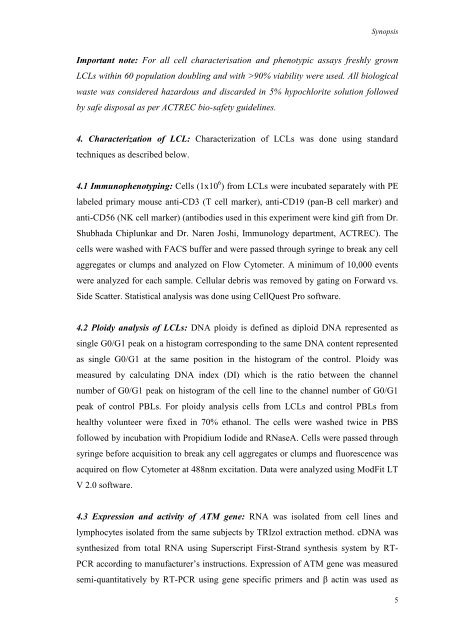LIFE09200604007 Tabish - Homi Bhabha National Institute
LIFE09200604007 Tabish - Homi Bhabha National Institute
LIFE09200604007 Tabish - Homi Bhabha National Institute
You also want an ePaper? Increase the reach of your titles
YUMPU automatically turns print PDFs into web optimized ePapers that Google loves.
Synopsis<br />
Important note: For all cell characterisation and phenotypic assays freshly grown<br />
LCLs within 60 population doubling and with >90% viability were used. All biological<br />
waste was considered hazardous and discarded in 5% hypochlorite solution followed<br />
by safe disposal as per ACTREC bio-safety guidelines.<br />
4. Characterization of LCL: Characterization of LCLs was done using standard<br />
techniques as described below.<br />
4.1 Immunophenotyping: Cells (1x10 6 ) from LCLs were incubated separately with PE<br />
labeled primary mouse anti-CD3 (T cell marker), anti-CD19 (pan-B cell marker) and<br />
anti-CD56 (NK cell marker) (antibodies used in this experiment were kind gift from Dr.<br />
Shubhada Chiplunkar and Dr. Naren Joshi, Immunology department, ACTREC). The<br />
cells were washed with FACS buffer and were passed through syringe to break any cell<br />
aggregates or clumps and analyzed on Flow Cytometer. A minimum of 10,000 events<br />
were analyzed for each sample. Cellular debris was removed by gating on Forward vs.<br />
Side Scatter. Statistical analysis was done using CellQuest Pro software.<br />
4.2 Ploidy analysis of LCLs: DNA ploidy is defined as diploid DNA represented as<br />
single G0/G1 peak on a histogram corresponding to the same DNA content represented<br />
as single G0/G1 at the same position in the histogram of the control. Ploidy was<br />
measured by calculating DNA index (DI) which is the ratio between the channel<br />
number of G0/G1 peak on histogram of the cell line to the channel number of G0/G1<br />
peak of control PBLs. For ploidy analysis cells from LCLs and control PBLs from<br />
healthy volunteer were fixed in 70% ethanol. The cells were washed twice in PBS<br />
followed by incubation with Propidium Iodide and RNaseA. Cells were passed through<br />
syringe before acquisition to break any cell aggregates or clumps and fluorescence was<br />
acquired on flow Cytometer at 488nm excitation. Data were analyzed using ModFit LT<br />
V 2.0 software.<br />
4.3 Expression and activity of ATM gene: RNA was isolated from cell lines and<br />
lymphocytes isolated from the same subjects by TRIzol extraction method. cDNA was<br />
synthesized from total RNA using Superscript First-Strand synthesis system by RT-<br />
PCR according to manufacturer‟s instructions. Expression of ATM gene was measured<br />
semi-quantitatively by RT-PCR using gene specific primers and β actin was used as<br />
5

















